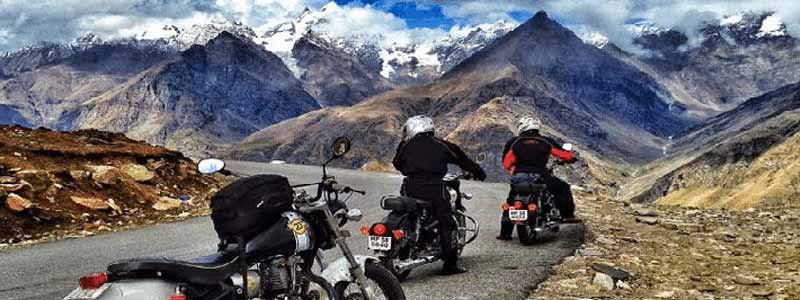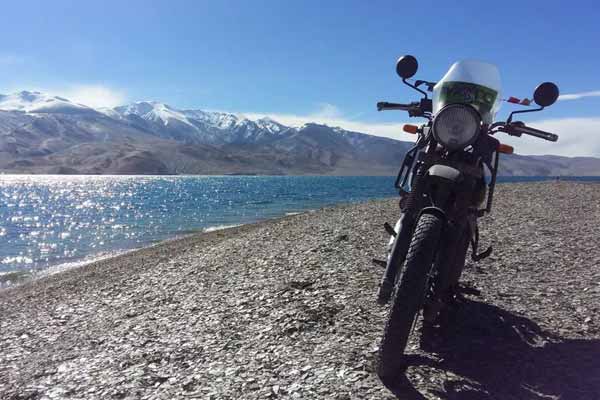5 Best Places For Mountain Biking in India is another spectacular adventure that will take bikers to uncharted territory. Manali’s snow-capped mountains, Leh’s harsh terrains, the Spiti Valley’s downhill, Garhwal’s Ganges bank, and Himachal’s lush green hills provide for an ideal base camp for a mountain biking journey in India. The air in these places is so magical that it acts as a calming agent a soothing balm for sore muscles Bikers are not restricted to any specific pathways; they can go in any direction they desire, take any route they choose, and base themselves wherever they like.
Passing through India’s distinctive landscape necessitates a great deal of endurance, patience, stamina, and courage. With each paddle, you will have the opportunity to discover a new planet. 5 Best Places For Mountain Biking India will allow you to discover places that are otherwise unknown to the general public. Although all mountain bikes are capable of carrying you to the rough side of the landscape, there are some measures that every biker should take.
Before embarking on a mountain cycling excursion in India, it is recommended that you practise cycling with fervour and intensity. You should be knowledgeable enough to navigate uneven trails; at that time, cyclists should know how to paddle because there will be no one to assist them for kilometres. Carry enough water to stay hydrated, as well as a multi-tool, a spare tube, a puncture kit, and a tiny pump.
Choose from the fascinating programmes available at the RTP if you are a bike enthusiast or want to unleash your inner adventurer. Mountain Biking tour packages available at RTP should not be missed by anyone who enjoys exploring the lush greenery of Himachal Pradesh, the huge mountains of Ladakh, or the hilly terrains of Garhwal and Kumaon. 5 Best Places For Mountain Biking India Specialists will recommend the ideal mountain biking package for you, taking into account all of your requirements. As a result, make the most of your trips by booking a vacation with us.

Guwahati to Tawang
The journey, which begins in Guwahati and ends in Tawang, is lengthier, but it is well worth the hype and effort. Starting from Bhalukpong on the Assam-Arunachal border, the Guwahati to Tawang bike excursion is one of India’s top mountain biking tracks. This voyage takes you through Arunachal Pradesh’s western regions, including Jamiri, Bomdila, and Sangti. You will progressively gain height on hills with spectacular tropical forest vistas throughout the first few days. Consider yourself travelling through the Kameng River, which is flowing alongside you!
Mountain biking from Guwahati to Tawang will take you across three mountain passes: Nechiphu, Bomdila, and the beautiful Sela Pass, all of which are at an elevation of 4200 metres (approx.). The Guwahati to Tawang excursion is comparable to the Manali mountain bike excursion for many nomads who prefer to spend the majority of their time on the road, 5 Best Places For Mountain Biking India.
Wow Factor: Crossing dozens of alpine lakes and riding on the 4600 m (approx.) Bum La Pass and 4200 m (approx.) Sela Pass is the highlight.
Days Required: 12-13 days (approx.)
Best Time to Visit: April to October
Destinations Covered: Guwahati – Bhalukpong – Jamiri – Bomdila – Sangti – Dirang – Senge – Jang – Tawang – Bum La – Bomdila
Sikkim, North East India
Because it contains several hairpin curves at high altitudes, Sikkim’s tourist circuit is a boon for serious mountain bikers. The adventure begins at a minimum elevation of 1650 metres (about) and ends at a maximum elevation of 2000 metres (approx.). The route takes you through lush green valleys, snow-capped mountain passes, and centuries-old monasteries, providing a welcome break from the mundane of city life.
You can breathe in the pristine mountain air of Sikkim while passing through numerous rural hamlets. After Ladakh, this magnificent India’s best mountain riding track is regarded India’s second most recognised mountain biking destination. Starting from the capital, Gangtok, and continuing beyond is the best way to experience the tour, 5 Best Places For Mountain Biking India.
Wow Factor: The hairpins invoke the thrill, even inexperienced mountain bikers.
Days Required: 15-18 days (approx.)
Best Time to Visit: October to December, and April to June
Destinations Covered: Gangtok – Ranka – Martam – Sirwani – Temi – Ravangla – Maenam Peak – Borong – Tashiding – Yuksom – Khecheopalri Lake – Pemayangtse – Rinchenpong – Jorethang
Kangra Valley, Himachal Pradesh
Imagine yourself on a mountain bike, taking in the breathtaking views of tea gardens, the Dhauladhar Range, and pine or deodar forests. The entire motorbike circuit in Kangra Valley stretches for around 260 kilometres and requires investigation if you wish to be surprised by the Kangra Valley‘s unspoiled lush green panoramas. You’ll find steep slopes that will pump up your adrenaline!
All you have to do now is figure out when the optimum time is to go mountain riding in Kangra Valley. Monsoons should be avoided, and you should be very cautious about the type of 5 Best Places For Mountain Biking India you’re riding and whose operator you’re renting from.
Wow Factor: You get to enjoy voyaging on the wheels at the home of one of the oldest surviving dynasties in the world.
Days Required: 5-7 days (approx.)
Best Time to Visit: March to May, October to February
Destinations Covered: Bir – Jogindernagar & Barot – Rajgundha – Billing
Munnar, Kerala
Munnar should be on your bucket list if you are from South India and want to ride some of the top mountain biking routes in the country. Munnar is the best mountain riding destination in South India because of the enormous expanse of greenery in the shape of tea gardens, spice farms, Cardamom Estates, and Shola Forests.
On mountain bike trips in the Munnar, you can explore various waterfalls and camping places. You will get the opportunity to interact with local villages and shoot farmers working in the tea garden hills during your journey. Mountain riding in Munnar is suitable for both beginners and experienced riders.
Wow Factor: The refreshment of passing through emerald tea garden hills can’t be summed up in words.
Days Required: 1-5 days (approx.)
Best Time to Visit: March to May, and December to February
Destinations Covered: Munnar – Periyar
Manali-Leh
No other mountain riding locations in India sound as intriguing to Delhiites as the Manali – Leh route. Manali is wonderfully situated between Dhauladhar and Pir Panjal peak, and is regarded as the origin of mountain riding trips in India. There are numerous gorgeous valleys, attractive villages, and quirky pathways that wind through lush deodar woods within Manali. 5 Best Places For Mountain Biking India adventures can be taken within Manali to explore the valleys in a shorter amount of time.
Plan a Leh trip through Manali route and stop overnight at various halting locations like as Keylong, Jispa, and Sarchu if you have dedicated time to spend 12-14 days on the road. Manali was historically the commercial route to Ladakh, and it still remains today, the adventure capital of Himachal Pradesh, Manali serves as a route to reach Ladakh and visit Khardung La Pass, Changla Pass, Baralacha Pass, Lachung La Pass, Rohtang Pass, and other high altitude mountain passes of the region, 5 Best Places For Mountain Biking India.
Wow Factor: You get to enjoy mountain biking at an elevation of 2050 m to 4000 m (approx.).
Days Required: 13-14 days (approx.)
Best Time to Visit: July to September
Destinations Covered: Manali – Marhi – Sissu – Jispa – Zing Zing Bar – Brandy Nallah – Pang – Tso Kar – Upshi – Leh – Khardungla – Leh
